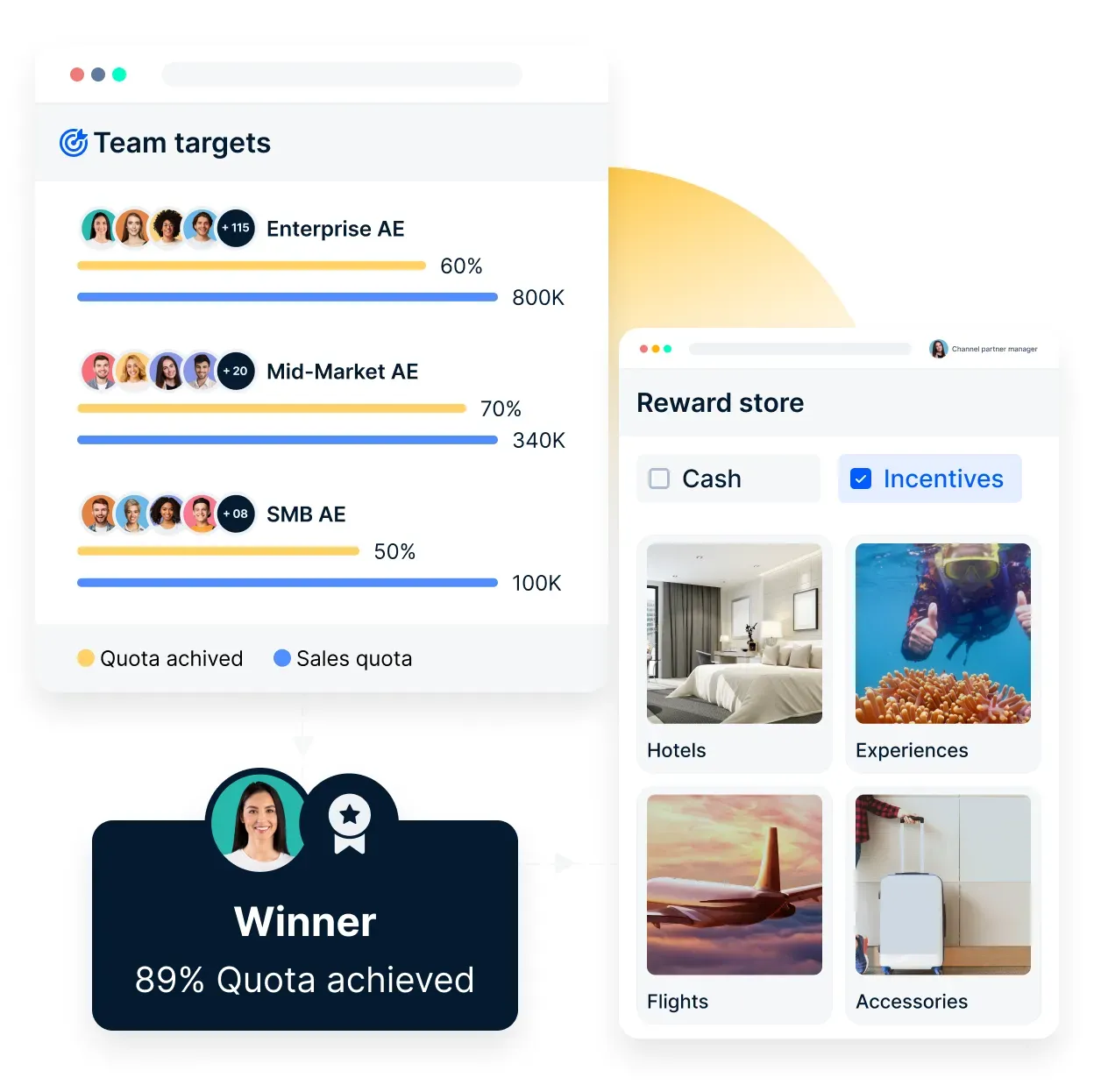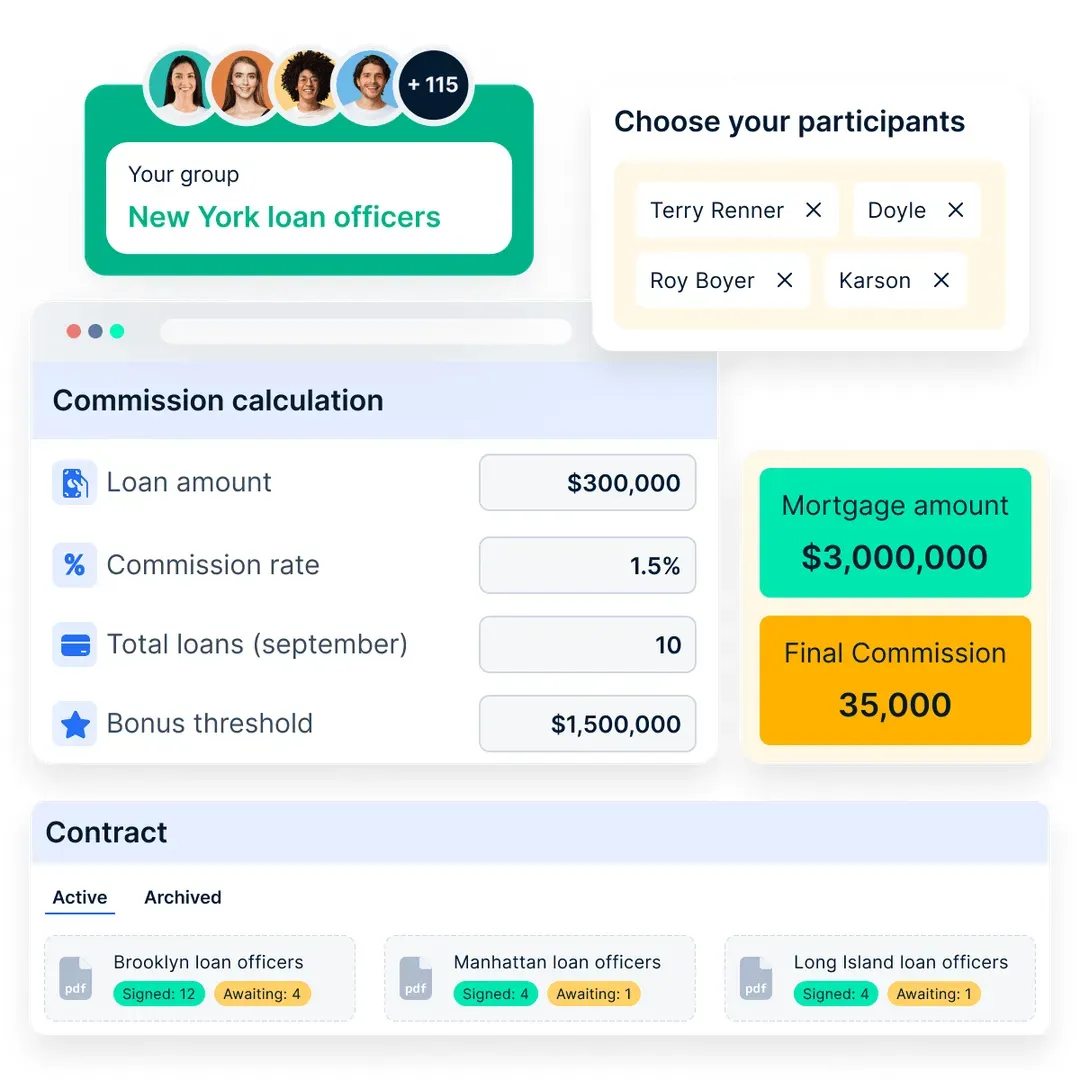Sales Operations Demystified: Was es ist, warum es wichtig ist und wie man es richtig macht
Vertriebsabläufe rationalisieren Prozesse, optimieren die Strategie und steigern den Umsatz. Erfahren Sie mehr über den Bereich, die 12 wichtigsten Aufgaben und wie er die Vertriebsleistung und das Unternehmenswachstum steigert.
Auf dieser Seite
Die Vertriebsabteilung, die ihren Ursprung in den 1970er Jahren bei Xerox hatte, spielte eine Schlüsselrolle beim Prognosemanagement, der strategischen Planung und der Gebietsplanung. Er sollte all die Aufgaben hinter den Kulissen übernehmen, die niemand erledigen wollte, die aber für den Erfolg des Teams unerlässlich sind. Vier Jahrzehnte später ist der Vertriebsbereich eine deram schnellsten wachsenden Rollen im Vertriebmit seinem Einfluss auf jeden Aspekt des Verkaufsprozesses.
Standardisierte und gut etablierte Vertriebsabläufe sorgen für einen kontinuierlichen Fluss von Leads durch die Pipeline. Andernfalls können die Vertriebsaktivitäten schnell in einen Zustand der Unordnung geraten, bei dem Opportunities durch die Maschen fallen und der Umsatz sinkt. Etwa 85 % der Vertriebsprofis sind der Meinung, dass die Vertriebsabläufe im Laufe der Jahre strategischer geworden sind, so die StudieSaleforceState of SalesBericht. In derselben Umfrage gaben 90 % an, dass die Vertriebsteams eine wichtige Rolle bei der Förderung des Wachstums spielen.
Was sind Verkaufsaktivitäten?
Sales Operations ist ein System aus standardisierten Prozessen, die alle Aspekte des Vertriebs regeln, von der Vertriebsstrategie, dem Lead-Management, der Gebietsstrukturierung und -ausrichtung bis hin zu Provisionsplänen, Optimierung, Automatisierung, Datenanalyse, Schulung und Berichterstattung. Es ermöglicht Vertriebsunternehmen, konsequent Leads zu generieren, Beziehungen zu pflegen und Verkäufe abzuschließen, um den Umsatz zu steigern.
Die Vertriebsabteilung legt die täglichen Ziele für die Vertriebsmitarbeiter und ihre Manager fest. Dazu gehören Aufgaben wie der Abschluss von Pipeline-Phasen und die sorgfältige Dateneingabe für die Vertreter sowie Mitarbeitermotivation, Vergütung und Ressourcenzuweisung für die Manager. Ein gut strukturierter und formalisierter Vertriebsbetrieb definiert klar die Rollen und Verantwortlichkeiten der einzelnen Teammitglieder und richtet Prozesse ein, um die Einhaltung der Vorgaben zu gewährleisten.
Wie Vertriebsabläufe den Verkaufsprozess verbessern
Im Kern sorgt der Vertrieb für vorhersehbare Umsätze, indem er den Vertriebsprozess durch Best Practices, Automatisierung und datengesteuerte Strategien optimiert. Vertriebsteams analysieren Vertriebsdaten, identifizieren Trends und erstellen Berichte, die die gesamte Vertriebs- und Betriebsplanung unterstützen.
1. Steigerung der Effizienz im Verkaufsprozess
Vertriebsmitarbeiter verbringen nur 28 % ihrer Zeit mit dem aktiven Verkauf. Ziel der Vertriebsabteilung ist es, die Verkaufszeit zu maximieren, indem manuelle Aufgaben durch Automatisierung und Prozessverbesserungen eliminiert werden. Ein kürzlich veröffentlichter Bericht über Trends in Sales Ops besagt, dass 94 % der Vertriebsorganisationen planen, ihren Tech-Stack innerhalb des nächsten Jahres zu konsolidieren, um die Effizienz zu steigern.
2. Ermittlung und Skalierung bewährter Verfahren
Sales-Ops-Teams analysieren kontinuierlich Vertriebstrends, ermitteln erfolgreiche Strategien und standardisieren sie im gesamten Unternehmen. Indem sie den Vertriebszyklus verfeinern, helfen sie den Teams, Geschäfte schneller abzuschließen.
Wenn z. B. ein besonders leistungsstarker Vertriebsmitarbeiter seine Quote aufgrund einer bestimmten Ansprachesequenz regelmäßig übertrifft, kann die Vertriebsabteilung diesen Ansatz unternehmensweit umsetzen. So können sich neue Mitarbeiter schneller einarbeiten und die Effektivität des Vertriebs insgesamt verbessern.
3. Steigerung der Verkaufsleistung durch Erkenntnisse
Die Vertriebsabteilung verwandelt Rohdaten in verwertbare Erkenntnisse. Durch die Verfolgung der wichtigsten Leistungsindikatoren (Key Performance Indicators, KPIs) und die Vorhersage von Verkaufsergebnissen liefern sie wichtige Daten für die Entscheidungsfindung. Diese Erkenntnisse reichen von Umsatztrends auf höchster Ebene bis hin zu detaillierten Metriken für die Vertriebsaktivitäten, wie z. B. die Anzahl der ungelösten Kundeneinwände.
Darüber hinaus identifizieren die Vertriebsteams potenzielle Engpässe, so dass die Führungskräfte ihre Strategien anpassen und sicherstellen können, dass die Teams ihre Ziele erreichen.
4. Strategische Planung der Verkaufsaktivitäten
Sales Ops spielen eine wichtige Rolle bei der langfristigen Vertriebs- und Betriebsplanung, indem sie mit den Vertriebsleitern zusammenarbeiten, um Wachstumsstrategien zu definieren und umzusetzen. Dieser Planungsprozess umfasst in der Regel Folgendes:
- Gebietsplanung - Sicherstellung, dass die richtigen Vertreter den richtigen Märkten zugewiesen werden.
- Kapazitätsplanung - Ermittlung des Einstellungsbedarfs auf der Grundlage der Verkaufsziele.
- Quotenplanung - Festlegung erreichbarer, auf die Prognosen abgestimmter Verkaufsziele.
- Vergütungsplanung - Gestaltung von Anreizstrukturen, die das gewünschte Verkaufsverhalten fördern.
Durch die Integration dieser Elemente legt der Vertrieb den Grundstein für ein nachhaltiges Wachstum und stattet die Vertriebsteams mit den Werkzeugen, Erkenntnissen und Strategien aus, die sie benötigen, um ihre Ziele konsequent zu erreichen und zu übertreffen. Schauen wir uns die Bereiche und Verantwortlichkeiten der Vertriebsabläufe an.
Umfang und Zuständigkeiten der Verkaufstätigkeit
Die Sales-Ops-Teams können aus einer Handvoll Personen bis zu mehr als einem Dutzend Experten in einem Team bestehen, je nach Größe des Unternehmens und Umfang der Tätigkeiten. Ihre Aufgabe ist es, die Produktivität, die Effizienz und die geschäftlichen Auswirkungen der Vertriebsteams zu steigern. Hier sind die Bereiche, die der Sales Operations Prozess beeinflussen kann:
1. Organisation des Verkaufsteams
Die Vertriebsmitarbeiter beeinflussen die Organisation der Vertriebsteams, um deren Effizienz und Leistung zu maximieren. Sie würden die Teams auch umstrukturieren, um gutes Verkaufsverhalten zu fördern und schwache Leistungen abzufedern. So würden sie beispielsweise die Stärken und Schwächen der einzelnen Vertriebsmitarbeiter berücksichtigen und sie so positionieren, dass sie mit den Kunden zu tun haben, bei denen sie ihre beste Leistung erbringen.
2. Kommunikation im Verkaufsteam
Die Vertriebsmitarbeiter bauen die Kommunikationsstruktur in den Teams auf, um Transparenz und Teamausrichtung zu gewährleisten. Sie nutzen verschiedene Kanäle für die Berichterstattung über Verkäufe und Kampagnen sowie für Ankündigungen, Nachrichten und Verkaufsgewinne. Sie stellen sicher, dass die gesamte Kommunikation, die zum Erreichen von Spitzenleistungen erforderlich ist, vorhanden ist und von den Mitarbeitern in vollem Umfang genutzt wird.
3. Verkaufsstrategie
Die Verkaufsabteilung hat die Aufgabe, Pläne fürVerkaufsstrategiepläneauf der Grundlage ihrer Datenanalyse und -prognose zu erstellen. Sie legen künftige Verkaufsziele fest und entwickeln Strategien für die Teams, um die Verkaufszyklen zu verkürzen, die Konversionen zu verbessern und die Verkaufsgewinne zu maximieren.
4. Ausbildung
Um eine vorhersehbare Leistung zu erzielen, müssen die Vertriebsmitarbeiter für ihre Aufgaben gut geschult sein. Die Vertriebsabteilung übernimmt die Verantwortung für die Schulung sowohl der bestehenden als auch der neuen Vertriebsmitarbeiter. Sie würden auch Mentorenprogramme und teambildende Maßnahmen entwickeln undHR-Management-Software-Toolsum eine gesunde Arbeitskultur zu fördern, dieVertriebsmitarbeiter motiviertund das Engagement verbessert.
5. Definition des Gebietes
Vertriebsgebiete bestimmen eine Reihe von Variablen für die Vertriebsmitarbeiter, z. B. ihren Interessentenpool, das Gesamtgeschäft, die verfügbaren Provisionen und sogar die Arbeitsbelastung. Da die Vertriebsabteilung für Prognosen und Strategien zuständig ist, ist sie auch für die Gebiete verantwortlich, um sicherzustellen, dass die besten Vertriebsmitarbeiter in den richtigen Gebieten eingesetzt werden.
6. Technologie-Management
Sales Ops schließen die Lücke zwischen den technischen Teams und den Vertriebsmitarbeitern, um die richtigen Tools und Schulungen einzuführen, die für eine optimale Leistung der Vertriebsmitarbeiter erforderlich sind. Sie sind auch für die Schulung und Implementierung der Technologie verantwortlich, die den Verkaufsprozess rationalisiert.
7. Lead-Generierung
Die Vertriebsmitarbeiter erledigen administrative Aufgaben wie Terminbuchungen undLead-Generierungmit Kontakten und Leads. Da diese Aufgaben separat erledigt werden, können sich die Vertriebsteams mehr auf den Verkauf und die Pflege von Leads konzentrieren. Es wird klar kommuniziert, wer in den Vertriebsteams die Buyer Personas verfolgen kann und wer die qualifizierten Leads aus dem Marketing übernehmen darf.
8. Unterstützung der Vertriebsmitarbeiter
Die Hauptaufgabe von Sales Ops besteht darin, den Prozess zu rationalisieren, damit die Vertriebsmitarbeiter ihre Arbeit effizient erledigen können. Dies geschieht durch verschiedene Aufgaben wie Mentoring, Schulung für die Rolle, Erstellung von Kontakten, Bereitstellung von Leads und Verwaltung von Transaktionen. Sie unterstützen die Vertriebsmitarbeiter auch auf andere Weise, indem sie Technologien und Kommunikationsmittel bereitstellen, die dazu beitragen, mehr Leads zu pflegen und abzuschließen.
9. Verwaltung der Verkaufsdaten
Vertriebsdaten sind wichtig, um die Leistung des Vertriebsprozesses, der Kampagne, des Produkts und sogar der Strategie zu verstehen. Vertriebsmitarbeiter nutzen diese Daten, um Änderungen an bestehenden Prozessen vorzunehmen oder umneue Vertriebspläne zu erstellenwenn die Daten die Notwendigkeit dazu erkennen lassen. Daten aus der Konkurrenzforschung, Markttrends und interne Leistungen werden ebenfalls genutzt, um die Vertriebsstrategie zu ändern und neue Ziele zu setzen.
10. Absatzprognose
Die Verkaufsprognoseist ein wesentlicher Schritt, der eine Referenz für die zukünftige Leistung der Vertriebsteams darstellt. Die Vertriebsmitarbeiter verwenden Daten aus früheren Zyklen, die Leistung und bestehende Markttrends, um Umsatzschätzungen für den Monat, das Quartal oder das Jahr zu erstellen. Prognosen helfen bei wichtigen Geschäftsentscheidungen wie der Einstellung neuer Ressourcen, der Erkennung von Ineffizienzen in Vertriebsteams oder -strategien und der Umstellung auf neue Ansätze in Krisenzeiten.
11. Planung von Verkaufsanreizen
Verkaufsanreize werden benötigt, um Vertriebsmitarbeiter zu motivieren, ihre Verkaufsziele zu erreichen oder zu übertreffen. Sie werden zusätzlich zur Standardvergütung angeboten, und die Vertriebsmitarbeiter haben die Aufgabe, aus den verschiedenen Arten von Incentive-Programmen auszuwählen. Durch die Schaffung großartiger Incentive-Programme können die Vertriebsmitarbeiter zeigen, dass ihre Arbeit geschätzt wird und sie für das Unternehmen wertvolle Mitarbeiter sind.
12. Gamifizierung des Verkaufs
Gamification im Vertriebnutzt Spielmechanik, -dynamik und -techniken, um gewünschte Verhaltensweisen und Verkaufsleistungen zu fördern. Richtig angewandt, bringt Gamification Schwung in den Verkaufsprozess und steigert das Engagement. Während Verkaufswettbewerbe, die in der Vergangenheit
Wie können Sie Ihren Vertrieb strukturieren?
Die Strukturierung IhrerVerkaufsaktivitätenerfordert die Festlegung klarer Verkaufsziele und das Verständnis der besonderen Herausforderungen bei der Erreichung dieser Ziele. Wenn Sie diese Parameter festgelegt haben, haben Ihre Mitarbeiter und Manager mehr Klarheit, um die Verkaufsziele zu verfolgen. Hier sind 6 Schritte, um es richtig zu machen:
Schritt 1: Bestimmen Sie den Umfang der Maßnahmen
Der operative Bereich hat damit zu tun, wie Ihr Verkaufsprozess abläuft. So kann Ihr Unternehmen beispielsweise die traditionelle Kaltakquise nutzen, um viele Leads auf einmal anzusprechen, oder Content Marketing und Online-Werbung einsetzen, um ausschließlich hochwertige Leads zu generieren. Der Arbeitsumfang ist in beiden Fällen unterschiedlich und hat seine eigene Reihe von Vertriebsprozessen, Rollen, unterstützenden Aufgaben und Kernkennzahlen. Wenn Sie von oben nach unten arbeiten, können Sie eine Strategie entwickeln, einen Vertriebsvorgang einrichten, der auf die Strategie abgestimmt ist, und schließlich die Ressourcen zur Erreichung der Ziele einsetzen.
Schritt 2: Erstellen des Verkaufsprozesses
Der Verkaufsprozess ist eine standardisierte Reihe von Verfahren, um potenzielle Kunden zu finden, sie auf das Produkt aufmerksam zu machen, ihr Interesse zu wecken und sie schließlich zu einem Kauf zu bewegen. Der Vertriebsprozess umfasst also Elemente wie Kaltakquise, Produkteinführung, Anrufe zur Qualifizierung von Interessenten und Kundentreffen zur Präsentation von ProduktVorschläge.
Der typische Verkaufsprozess umfasst sowohl einen Verkaufstrichter als auch eine Verkaufspipeline. Der Verkaufstrichter stellt dar, wo sich die potenziellen Kunden in ihrem Kaufprozess befinden. Er umfasst Phasen wie Markenbewusstsein, Interesse an Ihrem Produkt oder Ihrer Dienstleistung, Erwägen eines Angebots und schließlich eine Kaufentscheidung. Die Vertriebspipeline besteht aus den internen Aktivitäten, die den Leads helfen, den Trichter zu durchlaufen.
# Beispiel 1
Hier ein Beispiel für den Verkaufsprozess eines Unternehmens, das direkt und in großem Umfang Leads generiert:
- Vertriebsmitarbeiter im Innendienst sondieren Leads online oder in sozialen Medien und geben deren Daten in das CRM ein.
- Die Vertriebsmitarbeiter im Innendienst führen Kaltanrufe bei den im CRM erfassten Kunden durch, um deren Interesse und Bedürfnisse zu ermitteln und Verkaufspräsentationen zu vereinbaren.
- Die Außendienstmitarbeiter führen Verkaufspräsentationen mit interessierten Kunden durch. Wenn die Leads den Trichter zur Preisgestaltung durchlaufen, wird ein Angebot verschickt. Wenn die Präsentation nicht überzeugt, werden die Leads zurückgeschickt, um durch E-Mails und anschließende Anrufe gepflegt zu werden.
- Nach dem Preisangebot gehen die Interessenten in die Verhandlungsphase über und lassen sich vom Berater über Leistungen, Bedingungen und Preise beraten.
- Der Interessent trifft eine Kaufentscheidung. Wenn das Geschäft zustande kommt, wird der Kunde aufgenommen und an das Kundenbetreuungsteam weitergeleitet. Wenn das Geschäft nicht zustande kommt, wird der Interessent zurück in die Pflegephase geschickt.
# Beispiel 2
Hier ein Beispiel für den Verkaufsprozess eines Unternehmens, das Content Marketing und Online-Werbung nutzt, um Leads zu generieren:
- Der Interessent gibt seine Daten in ein Online-Webformular ein und wird im CRM automatisch als Lead bewertet, der einem Vertriebsmitarbeiter zugewiesen wird.
- Der Vertreter wendet sich per E-Mail an den Interessenten und bittet um einen Termin zur Vertriebsqualifizierung. Wenn der Interessent zustimmt, wird ein Treffen vereinbart; wenn nicht, wird der Lead zu einer automatischen Pflege-Liste hinzugefügt.
- Der Vertriebsmitarbeiter spricht mit dem Kunden während des Qualifizierungsgesprächs. Wenn der Lead abspringt, aktualisiert der Vertriebsmitarbeiter das CRM, um den Lead zu disqualifizieren und ihn aus der E-Mail-Liste zu entfernen.
- Interessierte Kunden verhandeln mit den Vertretern und den Beratern des Unternehmens über Bedingungen, Leistungen und Preise.
- Der Interessent trifft nach der Verhandlung eine Kaufentscheidung. Kommt das Geschäft zustande, wird der Interessent als Kunde aufgenommen und an das Kundenbetreuungsteam weitergeleitet. Wenn das Geschäft nicht zustande kommt, wird der Interessent zurück in die E-Mail-Liste und die Nurturing-Schleife geschickt, um nach einiger Zeit erneut kontaktiert zu werden.
Schritt 3: Festlegung von Verkaufsmetriken und KPIs
Vertriebskennzahlen und Leistungsindikatoren (Key Performance Indicators - KPIs) sind unerlässlich, um einen objektiven Blick auf die Leistung der Vertriebsteams im Vergleich zu historischen Zahlen und Prognosen zu erhalten. Im Folgenden sind einige der wichtigsten Kennzahlen aufgeführt, die eingeführt werden können:
Umwandlungsraten in der Pipeline
Diese messen die Effizienz der Pipeline und des Prozesses. Einige Beispiele sind:
- Lead-Qualifikationsrate:die Anzahl der Leads, die sich als Interessenten für das Produkt oder die Dienstleistung qualifizieren.
- Vorschlagsquote:gibt die Anzahl der Leads an, die einGeschäftsvorschlagnach einer Produktdemo oder -präsentation erhalten haben.
- Abschlussquote:Zeigt an, wie viele Leads zu Kunden wurden.
Gesamtzahl der Aktivitäten
Diese geben Aufschluss über die Bemühungen der Vertreter im Verkaufsprozess. Beispiele hierfür sind:
- Gesamtzahl der getätigten Anrufe:Anzahl der Cold Calls in einem bestimmten Zeitraum.
- Telefonzeit:Die Gesamtzeit, die in Minuten oder Stunden für ein Telefongespräch mit einem potenziellen Kunden aufgewendet wurde.
- Gesendete E-Mails:Gesamtzahl der über einen bestimmten Zeitraum gesendeten E-Mails zu Einführungszwecken.
- Dateneinträge von Interessenten:Alle in das CRM eingegebenen Daten zu Leads, Kontakten und anderen Informationen.
Metriken zur Verkaufsproduktion
Diese Zahlen geben die gesamte Verkaufsleistung an. Beispiele sind:
- Generierte Leads:Dies sind die gesamten Leads, die in einem bestimmten Zeitraum generiert wurden.
- Abgeschlossene Geschäfte:Gesamtzahl der Interessenten, die in Klienten oder Kunden umgewandelt wurden.
- Erzielter Umsatz:Gesamtumsatz, der von den Vertretern in einem bestimmten Zeitraum erzielt wurde.
Metriken zur durchschnittlichen Dauer
Diese Zahlen beziehen sich auf den durchschnittlichen Zeitaufwand für Verkaufsaktivitäten. Beispiele hierfür sind:
- Länge des Verkaufszyklus:Die durchschnittliche Zeit, die ein Vertriebsmitarbeiter benötigt, um ein Geschäft abzuschließen, sobald der Lead generiert wurde.
- Lead-Follow-up-Zeit:die durchschnittliche Zeit, die ein Vertriebsmitarbeiter benötigt, um den Lead nach der ersten Lead-Generierung zu kontaktieren.
Schritt 4: Unterstützende Verkaufsaufgaben einbeziehen
Zu den unterstützenden Aufgaben gehören alle anderen Aktivitäten, die zur Optimierung des Verkaufsprozesses beitragen. Dazu gehören administrative Aufgaben, Rekrutierung, Onboarding, Training und jede andere Aufgabe, die den Verkaufsprozess direkt beeinflusst. Beispiele hierfür sind:
- Erstellung von Umsatzprognosen zur Einschätzung des künftigen Wachstums und der Einnahmen.
- Erarbeitung von Marketingmaterial für die Produkte, das bei einer bevorstehenden Veranstaltung verteilt werden soll.
- Fakturierung und Rechnungsstellung an Kunden.
- Verfolgung der Verkaufsprovisionen und Anreize, die die Vertreter zu Höchstleistungen motivieren.
- Vertrieb undAnreiz-Gamifizierungum das Engagement hoch zu halten und mehr Geschäfte abzuschließen.
- Erforschung von Markttrends, um Einblicke in die Verkaufstätigkeit zu erhalten.
Schritt 5: Festlegung von Teamrollen und Quoten
Sobald Sie den Vertriebsprozess und die Messgrößen festgelegt haben, ist es an der Zeit, dem Team Rollen und Quoten zuzuweisen. Eine klare Definition von Rollen, Aufgaben und Zuständigkeiten ist unerlässlich, um ein gutes Maß an Kontrolle und Vorhersehbarkeit über den Vertriebsprozess zu erhalten. Bei der Zuweisung von Rollen sind verschiedene Aspekte zu berücksichtigen, wie z. B.:
- Die Anzahl der Vollzeit- oder Teilzeit-Vertriebsmitarbeiter, die Sie benötigen, um Ihre Ziele zu erreichen.
- Angemessene Aufteilung der Aufgaben auf Vertreter und Teammitglieder mit den richtigen Fähigkeiten und Qualifikationen.
- Das Ausmaß, in dem jeder Manager den Verkaufsprozess übersieht.
- Festlegung von Verkaufsquoten für einzelne Vertreter auf der Grundlage ihrer Erfahrung.
Schritt 6: Einbindung von Tools zur Verkaufsförderung
Der Prozess derVertriebsabläufelegt den Rahmen für den Vertriebsprozess fest, bestimmt die Aufgaben und legt Ziele, Rollen und Verantwortlichkeiten fest, um die Dinge in Gang zu bringen. Das Sales Enablement verbessert den Prozess und die Systeme des Vertriebs durch die Beseitigung von Hindernissen für die Effizienz und die Einbeziehung von Aufgaben, die die Produktivität steigern.
Sales Enablement kann so einfach sein wie die Umstrukturierung der Vertriebsteams oder die Integration von Technologien zur Rationalisierung der Prozesse. Wenn Sie z. B. feststellen, dass eine Vertriebseinheit aufgrund von nicht verkaufsbezogenen Aufgaben, die die Zeit des Vertreters in Anspruch nehmen, durchweg längere Vertriebszyklen hat, dann würde die Einführung eines automatisierten Tools die Zykluszeit verkürzen und die Effizienz steigern.
Messung des Erfolgs der Verkaufsaktivitäten
Der Erfolg des Vertriebs hängt von einer Reihe von Parametern ab, z. B. von den Einnahmen und davon, wie gut sie mit den Prognosen übereinstimmen oder diese übertreffen. Langfristiger Erfolg bedeutet, dass die gesetzten Ziele konsequent und vorhersehbar erreicht werden, und dies kann anhand einer Reihe von Kennzahlen gemessen werden, z. B:
- Prognosegenauigkeit:Dies ist eine wichtige Kennzahl, die Ihr Verständnis für die vorherrschenden internen und externen Verkaufsvariablen bestätigt. Die Prognosegenauigkeit ist der prozentuale Unterschied zwischen den prognostizierten und den tatsächlichen Einnahmen.
- Durchschnittliche Länge des Verkaufszyklus:Dies ist die durchschnittliche Zeit zwischen der Generierung eines Leads, der Kommunikation mit dem Vertreter und dem Abschluss eines Geschäfts. Je kürzer der Verkaufszyklus ist, desto besser ist die Leistung des Teams.
- Durchschnittlicher Quartalsumsatz pro Vertreter:Diese Kennzahl gibt Aufschluss darüber, wie gut Ihr Vertriebsteam arbeitet. Sie errechnet sich aus dem vierteljährlichen Umsatz geteilt durch die Gesamtzahl der Vertriebsmitarbeiter im Team.
- Durchschnittliche Verkaufszeit eines Vertreters:Diese Kennzahl gibt an, wie viel Zeit der Vertreter für Verkaufsaufgaben im Vergleich zu Nicht-Verkaufsaufgaben aufwendet. Je höher diese Kennzahl ist, desto besser ist es für den Vertrieb.
- Gewinnrate:Die Gewinnrate gibt an, wie viele Geschäfte die Vertriebsmitarbeiter abgeschlossen haben. Sie ist ein Indikator für die Effizienz der Vertriebsaktivitäten und des Befähigungsprozesses.
Wichtige Instrumente für Vertriebsteams
Die Effizienz des Vertriebs kann durch den Einsatz von Software zur Organisation, Bewertung, Verwaltung und Rationalisierung des Vertriebsprozesses erheblich gesteigert werden. Hier sind einige der wichtigsten Tools für den Vertriebsprozess:
1. CRM-Software
CRM-Software insbesondereVertriebs-CRMkann die Effizienz der gesamten Vertriebsabteilung erheblich verbessern, indem alle Daten an einem Ort organisiert werden. Außendienstmitarbeiter und Manager können Geschäfte in der Pipeline verfolgen und Echtzeitberichte über die Leistung einsehen. Aspekte des Arbeitsablaufs können auch automatisiert werden, und durch KI-gestützte Funktionen in den Tools können Einblicke in den Prozess gewonnen werden. Durch den Zugriff auf alle Daten in denCRM-Dashboardskönnen Außendienstmitarbeiter und Manager sofort Berichte erstellen und Prognosen erstellen, um die Leistung und die wichtigsten Kennzahlen zu verfolgen.
2. Instrumente zur Verkaufsförderung
Tools zur Verkaufsförderung ermöglichen es Ihnen, alle Inhalte und Materialien von einem Ort aus zu verwalten. Sie können alle Inhalte und Ressourcen erstellen, bearbeiten, verwalten und mit den Vertriebsmitarbeitern und Marketingteams teilen, um die teamübergreifende Funktionalität und Zusammenarbeit zu fördern. Vertriebsunterstützungs-Tools helfen auch dabei, neue Vertriebsmitarbeiter schneller einzuführen und ihre Schulung zu unterstützen.
3. Gamification-Tools für den Vertrieb
Gamification-Tools machen den Verkaufsprozess zum Vergnügen undnimmt die Langeweilevon der Aufgabe. Vertriebsmitarbeiter müssen Ablehnungen und nicht zustande gekommene Geschäfte hinter sich lassen, um bei ihrer Arbeit aufmerksam und engagiert zu bleiben. Gamification-Tools halten die Trommeln in Bewegung, indem sie Verhaltensweisen und nicht nur Ergebnisse belohnen und den Schwung des Verkaufsteams aufrechterhalten.
Compass, ein führendesGamification-Tool für den Vertriebmacht den gesamten Prozess der Gamification von Incentive-Programmen für Unternehmen einfacher.

Mit einfachen Tools für Programmdesign, Analysen, Live-Dashboards, Zielvorgaben und meilensteinbasierten interaktiven Spielvorlagen können Unternehmen ihre Incentive-Programme effizient verwalten.
Optimieren Sie Ihre Vertriebsabläufe mit fortschrittlichen Gamification-Tools, die das Engagement fördern, die Leistung verbessern und die Vertriebs- und Betriebsplanung rationalisieren. Stärken Sie Ihr Vertriebsteam mit:
- Personalisierte Dashboards - Gewinnen Sie Einblicke in Echtzeit, um Ihre Strategien für den Vertrieb zu verfeinern.
- Scorecards - Verfolgen Sie Leistungskennzahlen, um sie mit den wichtigsten Unternehmenszielen in Einklang zu bringen.
- Zielverfolgung - Setzen, überwachen und erreichen Sie Verkaufsziele effizient.
- KI-gestützte Stupser - Geben Sie intelligente Empfehlungen zur Steigerung der Produktivität.
- Echtzeit-Ranglisten - Fördern Sie einen gesunden Wettbewerb, um die Motivation zu steigern.
- Punkte und Abzeichen - Belohnen und erkennen Sie Leistungsträger an, um das Engagement zu steigern.
- Auszahlungshistorie - Verfolgen Sie Verdienst- und Provisionsstrukturen transparent.
- Engagement-Metriken - Messen Sie die Beteiligung von Vertretern, um die Vertriebs- und Betriebsplanung zu verbessern.
Nutzen Sie Gamification im Vertrieb, um die Vertriebsleistung zu optimieren, kontinuierliche Verbesserungen zu gewährleisten und die Vertriebsabläufe für langfristigen Erfolg zu stärken.
4. Instrumente zur Gebietsplanung
Tools für die Gebietsplanung können ebenfalls als Teil des Sales Enablement betrachtet werden und sind oft in der Suite enthalten. Sie verbessern die Effizienz der Vertriebsteams, indem sie die richtigen Gebiete den richtigen Vertriebsmitarbeitern zuweisen und sicherstellen, dass der Zielmarkt vollständig abgedeckt wird. Die richtige Gebietsplanung ist wichtig, um sicherzustellen, dass alle Vertriebsmitarbeiter eine faire Chance haben, ihre Ziele zu erreichen und gleichzeitig die gesamte Einheit voranzubringen.
5. Verkaufsanreize/Provisionen
Verkaufsanreize und Provisionen sind für die Motivation und das Engagement von Vertriebsmitarbeitern von entscheidender Bedeutung und stellen sicher, dass sie sich anstrengen, um ihre Ziele zu erreichen und zu übertreffen. Verschiedene Organisationen verwenden unterschiedliche Incentive-Pläne, umihre Vertriebsmitarbeiter angemessen zu belohnenum das beste Verkaufsverhalten zu fördern. Die manuelle Verwaltung von Incentives ist fehleranfällig und umständlich.
Die Vertriebsmitarbeiter greifen unter solchen Umständen auf eine Schattenbuchhaltung zurück, wodurch Zeit vergeudet wird, die ansonsten für den Verkauf genutzt werden könnte. Mit Anreizsystemen bleiben die Pläne transparent und Fehler bei der Provisionsberechnung werden vermieden, was das Vertrauen in die Vertriebsmitarbeiter stärkt und ihre Konzentration auf den Verkauf fördert.
MitCompasskönnen Unternehmen ihre Incentive-Programme automatisieren und Probleme wie nicht übereinstimmende Incentive-Beträge, häufige Korrekturen und Verzögerungen bei der Auszahlung von Incentives vermeiden. Auf der positiven Seite können sie eine klare Kommunikation, erhöhte Produktivität und Einsparungen bei den Incentive-Budgets durch die Beseitigung von Ineffizienz feststellen.

- Steigern Sie die Vertriebseffizienz, indem Sie Auszahlungsfehler und -verzögerungen durch ein automatisiertes Incentive Compensation Management (ICM ) vermeiden und so genaue und zeitnahe Erträge sicherstellen.
- Steigern Sie die Produktivität durch die Automatisierung komplexer Incentive-Berechnungen mit gebrauchsfertigen Vorlagen, die den manuellen Arbeitsaufwand reduzieren und den Vertriebsteams mehr Zeit für den Abschluss von Geschäften geben.
- Verbessern Sie die Transparenz und Rechenschaftspflicht mit strukturierten Genehmigungshierarchien für Einnahmen, Eskalationen und Streitbeilegung, um eine nahtlose Kommunikation zu gewährleisten und Fehlentwicklungen zu vermeiden.
- Optimieren Sie die Vergütungsplanung, indem Sie Incentive-Pläne mühelos mit einer No-Code-Plattform entwerfen, veröffentlichen und verwalten, die es Vertriebsleitern ermöglicht, Strategien sofort anzupassen - ohne technisches Fachwissen.
Abschließende Überlegungen
Der Vertrieb spielt eine wichtige Rolle bei der Generierung von Umsatzerlösen. Durch den Einsatz von Technologie können Vertriebsteams ihre Daten besser verwalten, um Erkenntnisse zu gewinnen, verkaufsfremde Aufgaben automatisieren, um die produktive Zeit zu erhöhen, und den Vertriebsprozess spielerisch gestalten, um Motivation und Engagement aufrechtzuerhalten. Die Zukunft des Vertriebs wird von einer weiteren Verbreitung von Technologien geprägt sein, die die Produktivität der Vertriebsmitarbeiter erheblich steigern werden.













